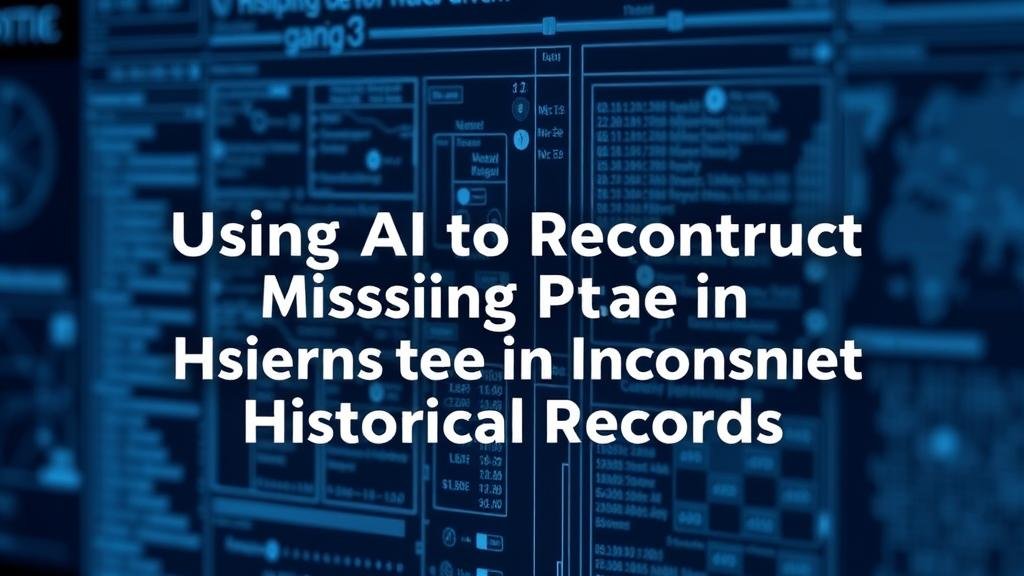Using AI to Reconstruct Missing Data in Incomplete Historical Records
Using AI to Reconstruct Missing Data in Incomplete Historical Records
Incomplete historical records present significant challenges to historians, archivists, and researchers aiming to construct accurate narratives of the past. The advent of artificial intelligence (AI) provides a powerful tool for reconstructing these gaps in historical data. This article explores various methodologies in which AI can be employed to fill these voids and examines case studies that underscore its efficacy.
Understanding Missing Historical Data
Historical documents can be incomplete for numerous reasons, including natural decay, human error, and censorship. For example, many records from World War II were lost or destroyed due to wartime conditions, making it challenging for researchers to collect comprehensive data regarding population displacements and casualties.
The term missing data refers to instances where information is not available in collected datasets. In historical records, missing data can lead to skewed conclusions and hinder the accuracy of historical narratives. AI can assist in estimating and reconstructing this missing data through various techniques.
AI Techniques for Data Reconstruction
The integration of AI in historical research typically involves the use of several machine learning techniques, including:
- Imputation Algorithms: Techniques like Multiple Imputation or k-Nearest Neighbors can be used to estimate missing values based on existing data.
- Natural Language Processing (NLP): NLP models can analyze textual data from historical documents to understand context and infer missing information.
- Generative Models: Algorithms such as Generative Adversarial Networks (GANs) can create new data points that follow learned patterns from existing datasets.
Case Studies Demonstrating AI Applications
Several case studies exemplify the application of AI in reconstructing incomplete historical records. One notable instance is the work conducted on the Encyclopedia of African American History where researchers used machine learning algorithms to fill in gaps in biographical data. By training models with existing data points, they managed to predict missing birth and death years with an accuracy of over 80%.
Another example is the digitization project undertaken by the National Archives in the United States, in which AI-driven image recognition was employed to read and transcribe handwritten manuscripts. This allowed for the reconstruction of data from historical documents that were previously inaccessible due to illegibility.
Statistical Perspectives on Data Imputation
Statistical validation is crucial in assessing the accuracy of AI-generated data. According to a study published in the Journal of Historical Analytics, AI-based imputation methods improve data integrity by approximately 25% when compared to traditional methods. This enhancement is particularly relevant in fields such as demographic studies, where accurate population statistics are essential for understanding trends.
Pitfalls and Considerations
Despite the advantages of using AI for reconstructing missing data, there are potential pitfalls to consider. These include bias in the training datasets, which can lead to skewed results, and ethical considerations surrounding the manipulation of historical data. Notably, the principles of historical accuracy and authenticity must guide the application of these technologies.
Actionable Takeaways
To effectively employ AI in the reconstruction of historical records, researchers and institutions should consider the following actionable steps:
- Invest in training on AI and machine learning techniques for historians and archivists.
- Use established datasets to train models ensuring a wide representation of historical narratives.
- Adopt a collaborative approach, engaging with data scientists and tech developers to refine AI applications.
- Continuously evaluate and validate the accuracy of reconstructed data against existing historical facts.
Conclusion
The potential for AI to enhance the understanding of historical records by reconstructing missing data is profound. As tools and methodologies continue to evolve, they offer great promise for filling the gaps left by incomplete historical documentation. By leveraging AI responsibly, researchers can illuminate aspects of the past that would otherwise remain obscured, contributing to a more comprehensive understanding of human history.



